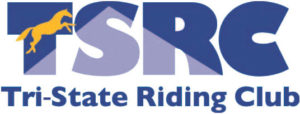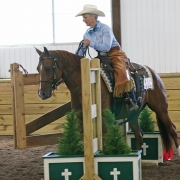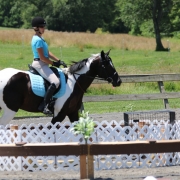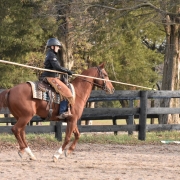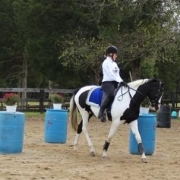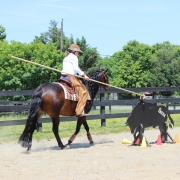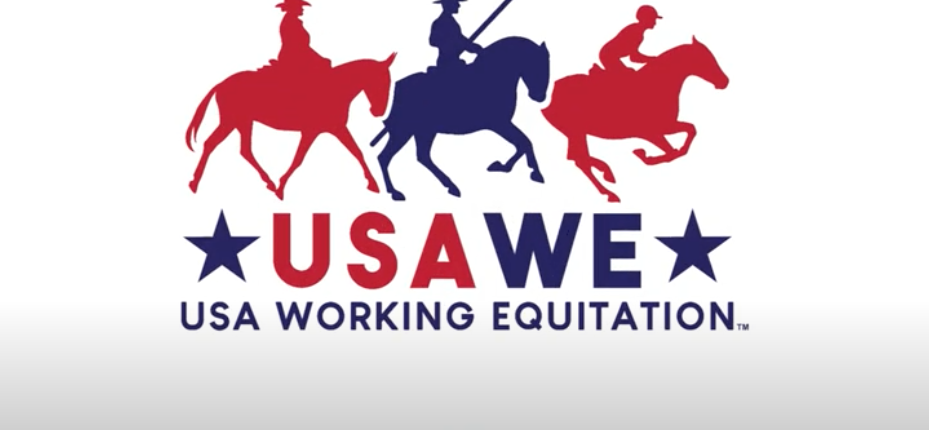This fun and all inclusive discipline is for both English and Western riders. Since TSRC introduced WE instruction to its lesson program in 2018, WE has been growing rapidly in the area.
Try TSRC Working Equitation Lessons with Stephanie Jennings!
Stephanie has ridden in many different events throughout her riding career. In 1987 she was National Reining Horse Association World Champion in Limited Non Pro on Bee Pine Fifty. Her career in the hunter ring includes three wins in Amateur Working Hunter at the All American Quarter Horse Congress and a 3rd place finish in the Amateur Hunter Hack at the AQHA World Championship Show. Riding her homebred Captured In Chrome she placed in the national top ten standings in AQHA Dressage in both Training Level and First Level.
Stephanie Jennings has been competing in the sport of Working Equitation (WE) since 2019. TSRC offers a couple of WE lessons each month where riders learn about the execution of the WE obstacles as well as how to refine that execution. Stephanie’s accomplishments in the sport of WE are:
- 2019 Confederation National Reserve Open Champion in Level 2
- 2021 USAWE National Open Reserve Champion in Level 4, Regions 5 & 6 Level 4 Open Champion
- 2022 USAWE National Level 4 – 8th place
- 2022 USAWE Regions 5 & 6 Level 4 Open Champion
What is Working Equitation?
Working Equitation in the United States follows the U.S. Rules for Working Equitation under the USA Working Equitation organization (USAWE). There are four possible trials in a Working Equitation Show, Dressage, Ease of Handling (EOH), Speed, and Cattle and 7 levels of competition (L1-L7). The Dressage Trial prepares the riders for the challenges encountered in fieldwork. The horse and rider perform a pattern of prescribed movements in a 20 x 40 m arena, and the judge scores each movement on a scale of 0 to 10. The EOH is the second trial where the horse/rider pair execute a course of obstacles, related to obstacles in the field. The judge also scores each obstacle on a scale of 0 to 10. There are also Collective Marks given in both the Dressage and EOH Trials. The Speed Trial (Levels 2 & up) tests the ability of the horse and rider to navigate a course of obstacles as quickly and accurately as possible. The Cattle Trial is not always offered at WE Competitions.
Level 1 (Intro) is an introduction to the sport of WE. Horses should show correct bend for the line of travel, and a willingness to work with his rider without resistance. All work is done in walk and trot.
Level 2 (Novice A) shows that the horse is developing more engagement and adjustability within the gaits. All work is done in walk, trot, and canter.
The complete Objectives of the Levels, the USA Rules for Working Equitation, Dressage tests (Appendix A), and Obstacles (Appendix B) can all be found at https://usawe.org/competitions/rules/.
Key points to remember:
- Do not enter the arena without the judge’s permission.
- Always salute the judge at the beginning and the end of the trial.
- You can use an occasional soft voice with your horse.
- Riders must use the same working hand for all obstacles that need to be handled.
- Level 1 riders are allowed to have dropped obstacles handed to them by the Ground Crew.
- You can’t go over or through any part of an obstacle until that obstacle has been executed on the course.
- Riders must use the same style of tack and attire in all trials.
- Mistreating the horse or excessive use of spurs or whip will result in disqualification.
To learn more about the sport:
For complete Working Equitation information and rules, visit the sport’s governing national organization–USA Working Equitation:
Articles for more general information:
What is Working Equitation, Dressage Today (click)
Working Equitation Today (click)
Working Equitation, Explained (click)
Sampling of some obstacles with brief explanations
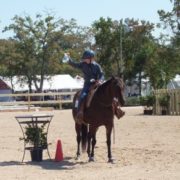
The Jug
The horse and rider approach the jug at the prescribed gait and halts beside the table. The rider raises the jug above his/her head then replaces the jug on the table. The horse must be immobile during this time.
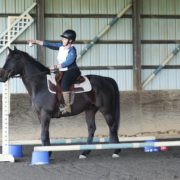
Bell Corridor
The horse and rider enter the corridor at the prescribed gait and halt at the end. The rider rings the bell and reins back through the corridor. Judges would like to see the diagonal pairs in the reinback.
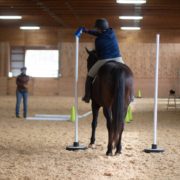
Switch Cup
Halt between poles, move the cup from one side to the other. Exit.
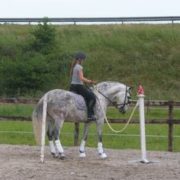
Gate
The horse and rider approach perpendicular to the gate, transition to the walk, move laterally towards the gate, then halt beside the gate. The rider must lift the latch, open the gate, go through the entrance, back a step or two and close the gate. This should be a fluid motion from the first halt to the final halt.
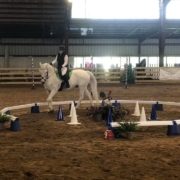
Pen
Enter the round pen at the walk (higher levels, canter). Complete the circle, exit, halt, turn on the haunches and complete the circle the other direction.
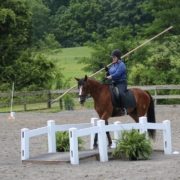
Bridge
Cross over the bridge.
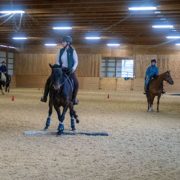
Sidepass Rail
Approach perpendicular to the pole and halt on one side. This may be a single pole or two parallel poles. If you have two parallel poles, you must change directions for second pole.
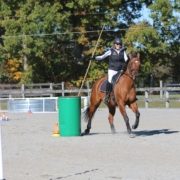
Remove Pole
The rider approaches the drum and retrieves the pole without stopping or breaking the gait required for the level. This obstacle is always used in conjunction with Replace Pole and sometimes Spear Ring. It can be part of a series or a separately judged obstacle.
Some rules and observations
- If you need to ride one-handed to touch or pick-up an object, always use the same hand to hold the reins and the same hand to handle the object.
- You can not switch hands when you need to handle the next object. In other words, if you use your right hand to pick up a cup or grab the pole, you must use your right hand every time.
- If you drop an object, (Level 2 or higher), you must dismount to retrieve it and remount with the object. Level 1 riders will be handed the object.
- Obstacles requiring a full halt, rider’s body should be even with the obstacle.
- Horse must be immobile if the obstacle requires a halt.
- The only obstacles that can be done at a canter for Levels 1 and 2 are the jump and the bank.
Disqualification and penalty samples
- You can not cross the line of an obstacle during the trail before it has been performed.
- Stroking or touching the horse’s neck in front of the rein hand three times. Penalty each time that occurs.
- Failure to ride through the course entry/exit markers in the direction indicated on the course map.
